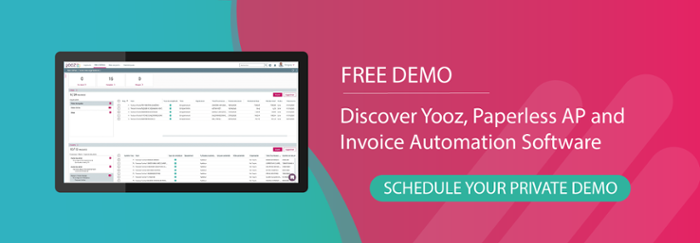The process of electronic AP approval has streamlined the Accounts Payable process for many companies. By automating this task, businesses can reduce errors, save time, and improve efficiency. However, there is much more that can be achieved through digital transformation and straight through processing.
Companies can leverage technology to completely overhaul their financial systems, implementing end-to-end digital processes that eliminate manual intervention and enable real-time decision-making. In this article we'll talk about the value of electronic invoicing and AP approval processes plus how embracing digital transformation can help to achieve greater agility, competitiveness, and profitability in the long term.
What Is the Invoice Approval Process?
The invoice approval process can be a time-consuming and complex task, especially when the AP department is handling large volumes of invoices and using manual processes. How does it work? The workflow to process invoices usually involves the following typical steps:
- Receiving: The Accounts Payable team receives the invoice or document, usually in paper form or by email.
- Entry: Data is manually entered into the accounting system.
- Routing: The invoice is routed to the relevant department or individual for approval.
- Review and Approval: The approver reviews the invoice, who then approves or rejects it.
- Payment: Once the invoice amount is approved, the finance team will issue payment.
In manual invoice processing there is a considerable risk of error, the potential for which only increases along with the volume.
Why Is the Manual Invoice Approval Process So Problematic?
According to global research by The Institute of Financial Operations and Leadership (IOFL), the switch to automated process has been slower than expected with the majority of global AP teams (54%) still only partially automated. The effect of this becomes even more apparent as the same report states that top processing challenges for AP teams include delays due to invoice exceptions (22%) and too much manual data entry (21%).
But why is a manual process so problematic? Why does it pose numerous problems for finance teams beyond being time-consuming and lengthy?
A manual process can lead to several additional issues, including duplicate payments, incorrect amounts, and missed deadlines. All of these can lead to wasteful spending, strained relationships with vendors, and a loss of credibility among both clients and suppliers.
The manual invoicing process is also slow, leading to processing delays. The delivery of paper invoices to different departments or locations for approval can add days or even weeks to the overall processing time. This lack of speed and efficiency can hinder a company's ability to track finances and make informed choices, which in turn make it more challenging to identify any financial issues.
In addition, relying on manual procedures increased the likelihood of errors, fraud, and non-compliance. Approvals may not conform to corporate policies and practices since they are not always documented correctly. And, without the documentation, it may be hard to track and identify any issues.
Manual invoice processing can also be expensive, draining resources in the form of paper, printing, and mailing, as well as the time and effort required for human data entry and approvals. As a company expands or adds multiple geographic locations - all of which involve a growing volume of bills - manual invoice validation processes can become unmanageable, causing further inefficiencies and affecting the company's overall productivity.
Embracing digital solutions such as AP automation systems can help to resolve all of these issues, helping businesses to ensure accurate financial records, save time and resources, improve vendor relationships, and make more informed decisions on how to drive growth and success.

How To Improve the Invoice Approval Workflow
The foremost way that businesses can enhance their Accounts Payable invoice approval workflow and optimize their Accounts Payable process is by implementing an Accounts Payable automation software solution.
Accounts Payable Automation Software
Accounts Payable automation software can help to digitize the payable invoice approval process, automate date entry, and provide real-time visibility into the status of invoices. By using automation software, business can reduce the risk of errors, speed up processing, and improve the overall efficiency of the invoice approval process. Electronic systems can also help to ensure that invoices are routed to the appropriate approver according to the company's policies and procedures.
Benefits of Implementing AP Automation
Implementing an electronic Accounts Payable approval process can offer multiple benefits. By streamlining the AP process, businesses can reduce processing times, eliminate manual errors, and improve financial transparency. Automation can also help to eliminate manual invoice data entry and routing, reducing the risk of errors and delays.
Real-time visibility into the status of any single invoice, can be quickly accessed, allowing businesses to monitor invoice progress throughout every stage of the approval process. And, by enforcing approval workflows, automation helps to ensure compliance with company policies and procedures, providing an audit trail of all invoice approvals. This in turn helps business not just in the Accounts Payable process but also to achieve overall greater financial control and accuracy.
In addition, automating the payment process can save time and strengthen connections with suppliers. This can increase a company's bargaining strength, allowing them to negotiate better deals and potentially even early payment discounts. Yes, this means that not only does the automation solution save money, but it can actually make money as well.
Finally, electronic payment methods such as bank-to-bank Automated Clearing House (ACH) and wire transfers can help to streamline the entire Accounts Payable department's invoice approval procedure from end-to-end.
Why Use a Cloud-Based AP Automation Provider
Cloud-based AP automation software providers offer many benefits over other types of AP automation software providers. These include:
- Accessibility: The software is accessible from anywhere at any time using an internet connection.
- Flexible: Cloud-based providers offer easy flexibility in terms of both deployment and scalability, allowing businesses to easily adjust their systems.
- Maintenance: A cloud-based system offers automatic software updates and maintenance, reducing the need for in-house IT resources and further reducing costs.
- Security: Data security and compliance is improved since the data is stored in secure, off-site services with regular backups.
- Information: The cloud provides a centralized data repository for easy access and improved analytics, reporting, and compliance purposes.
- Costs: Cloud-based AP automation providers offer additional cost savings since businesses only pay for the software services that they need - also known as Software-as-a-Services or SaaS - therefore avoiding any upfront hardware and software costs.
What Are Key Features to Look For In An Electronic AP Approval System?
Now that you know that automation can help improve the payable invoice approval process, what should a business look for in an electronic AP approval system? There are certain key features that businesses should seek when selecting an electronic AP approval system to ensure that it can streamline their Accounts Payable processes efficiently.
First, an ideal system should offer end-to-end invoice automation, from receiving and approving invoices to paying the vendor. This will save time and reduce the chances of manual error throughout the entire process.
Second, the system should have a reporting feature capable of tracking approvals and providing real-time status updates and notifications to stakeholders on the status of an invoice. The number and time of these notifications should be customizable based on the company's specific business processes, business rules, needs, or wants and include the ability to let you know where your bills stand in real-time, processing timeframes, payment approval statuses, and bottlenecks.
Third, it is essential to ensure that the system can integrate with other existing accounting systems used by your business. This will accelerate the implementation process and help enable a smooth flow of information.
Finally, a good automation system will provide a secure platform to store and retrieve invoices and related documents online, reducing the need for physical document storage and increasing accessibility. This, plus having the ability to enforce approval workflows and compliance, will help avoid any different legal requirements such as regulatory or compliance issues.

How Can an Automated AP Approval Workflow Improve Financial Transparency and Control?
Without question, the ability to have financial transparency and control is important. Not only will it facilitate checking and tracking cash flow but also becomes especially important for multinational companies that must comply with different legal requirements such as the European Union's e-invoicing rules. Other reasons include:
- Increase accuracy by reducing the chance of mistakes commonly found in a manual process and ensuring that bills are handled quickly and correctly with no unauthorized payments.
- Improve forecasting by providing real-time information, which means businesses can better manage their cash flow and make choices based on accurate, up-to-date information.
- Ensure a constant flow of timely approvals by being able to request approvals electronically, allowing for the addition of new approvers, compensating for temporary absences, and enforcing established approval routines. Furthermore, the system provides the flexibility to set approval parameters which further streamline the process.
An electronic process also keeps an updated record of all invoice signatures, which makes procedures clearer, more accountable, and easier to document.
Common Challenges and How To Overcome Them
Implementing an AP automation system can present challenges for some companies. A few of the most common include:
Resistance to change.
Employees may be hesitant to embrace new technology or workflows, leading to resistance to change and delays in implementation.
Involve key stakeholders in the process. Set clear expectations, communicating the benefits of the new system, addressing any concerns or questions that they may have. Make sure that the employees know that the intent isn't to eliminate jobs but rather simplify the work.
Integration issues.
Integrating the new system with existing accounting software or other systems can be complicated, especially for any company with an existing complex IT infrastructure.
Overcome integration issues by carefully planning the integrations process, knowing the ideal process and any specific needs that need to be addressed before you start. Know what accounting systems you and your vendors currently use and simplify the process by ensuring that your selected system can easily integrate with these specific systems.
Technical issues.
Technical issues such as system bugs or errors can arise during the implementation process, leading to delays and frustration for everyone involved in the implementation process.
Use an experienced automation platform with a dedicated implementation team and support. Know that you have a partner with whom you can work closely to ensure that any issues are resolved quickly. Conduct thorough testing before deployment and have a contingency plan in place.
Data migration.
Migrating data from existing systems to the new automated one can be challenging and time-consuming, especially if the data is in different formats or stored in multiple locations.
Have a clear data migration plan in place. Ensure data compatibility before beginning implementation.
Training and adoption.
Ensuring that employees are properly trained and adopting the new system can be a significant challenge, especially if the system is complex, has a large number of users, or the workforce is not tech-savvy.
Ensure that the vendor will provide comprehensive training, create user-friendly interfaces, and ensure that there will be ongoing support. Make sure that all this is communicated to the employees up front in order to alleviate fears.
Cost.
Implementing an AP automation system can be costly, especially if the chosen system requires any kind of significant customization or integration with another system.
Assess the cost-benefit ratio up front. Explore different pricing options and consider the long-term Return on Investment (ROI) of the system.

How Does Yooz Stand Out?
Yooz is an all-in-one solution, focused exclusively on automatic document processing and covering every step from purchase-to-payment. We have experience integrating with over 250 different financial management systems and dedicated support to ensure that your business gets the attention it deserves. However, our partnership extends past the implementation stage.
Yooz reinvests 25% of its revenue into in-house research and development to ensure that we provide the most modern technology, such as advanced Optical Character Recognition (OCR) and three-way data verification. Yooz also provides ongoing training through documentation and webinars integrated directly into the software itself.
Our customer focus has paid off: the company continues to experience 40+% annual growth worldwide.
Now What?
By automating the AP invoice approval process, you can easily reduce the amount of time that you spend processing invoices as well as improve strategic decision-making and cash flow management. Hopefully this guide has provided useful information for why to use Accounts Payable automation software as well as what features to look for in a provider.
However, knowledge is only half the battle, action is the next step. If you would like to learn more about how Yooz can help to streamline your own invoice management process using Accounts Payable process automation, contact us today to schedule a personal demo.






